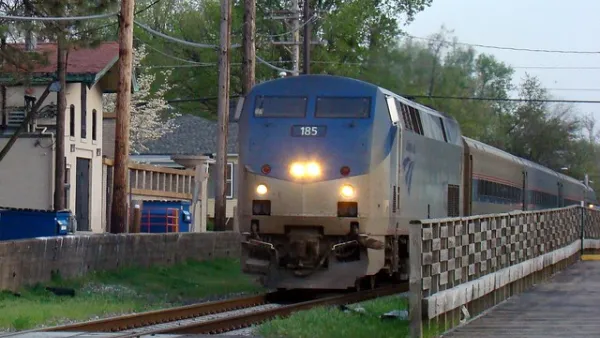Two transportation experts, Ken Orski, editor of Innovation Briefs and Joshua Schank, CEO of the Eno Center take opposing sides on whether it makes sense for the federal government to invest in high speed rail in this Wall Street Journal exclusive.
The Wall Street Journal editor poses the question, "Would funds for high-speed rail be better spent on improving existing intercity rail service?" While Orksi, editor and publisher of Innovation Briefs responds affirmatively, Schank does not deny the importance of improving existing rail service. "Yes, money is tight, and fixing what we already have would provide a greater immediate return. But isn't that always the case?", he asks.
However, Schank, President and CEO of the Eno Center for Transportation argues that incremental improvements are not enough, while Orski states that "until the U.S. regains its fiscal footing and has the financial resources to embark on a bold, capital-intensive endeavor, the federal government should forget about building a nationwide high-speed rail network and focus instead on modernizing existing rail infrastructure."
One of the main disagreements is whether the U.S. with its develolpment patterns would benefit from HSR as have Europe and Japan. Orski believes that only the Northeast Corridor should be considered while Schank cites travel statistics between Chicago and St. Louis to show how a "new high-speed rail line... could conceivably bring the travel time between the two cities down to less than 2.5 hours. After factoring in the challenges with airport security and traffic, this travel time would be highly competitive with airplanes and autos for people throughout both regions."
While Orski admits that the Northeast Corridor is a good candidate for HSR, he doesn't appear to support funding it other than "improving existing rail service-for instance, on signal systems, track alignments and station design."
Only "(w)hen the economy starts growing again, we might want to revive the idea of high-speed rail. Until then, prudence, good sense and the nation's well-being require that the federal government lower its sights", he concludes.
Schank ends his essay more optimistically.
"There is no doubt that building a high-speed rail network in the U.S. is an ambitious plan fraught with major funding and operational challenges. ...The U.S. can't afford to shy away from large investments out of fear. That is something second-rate countries do", he writes.
Two accompanying charts show rising Amtrak ridership since 2000 and "Amtrak's ten busiest lines in fiscal 2011 and their passenger counts".
The link to the article may be time-limited for those lacking WSJ electronic access.
Thanks to Mark Boshnack
FULL STORY: Would Funds for High-Speed Rail Be Better Spent on Improving Existing Intercity Rail Service?

Analysis: Cybertruck Fatality Rate Far Exceeds That of Ford Pinto
The Tesla Cybertruck was recalled seven times last year.

National Parks Layoffs Will Cause Communities to Lose Billions
Thousands of essential park workers were laid off this week, just before the busy spring break season.

Retro-silient?: America’s First “Eco-burb,” The Woodlands Turns 50
A master-planned community north of Houston offers lessons on green infrastructure and resilient design, but falls short of its founder’s lofty affordability and walkability goals.

Test News Post 1
This is a summary

Analysis: Cybertruck Fatality Rate Far Exceeds That of Ford Pinto
The Tesla Cybertruck was recalled seven times last year.

Test News Headline 46
Test for the image on the front page.
Urban Design for Planners 1: Software Tools
This six-course series explores essential urban design concepts using open source software and equips planners with the tools they need to participate fully in the urban design process.
Planning for Universal Design
Learn the tools for implementing Universal Design in planning regulations.
EMC Planning Group, Inc.
Planetizen
Planetizen
Mpact (formerly Rail~Volution)
Great Falls Development Authority, Inc.
HUDs Office of Policy Development and Research
NYU Wagner Graduate School of Public Service


























